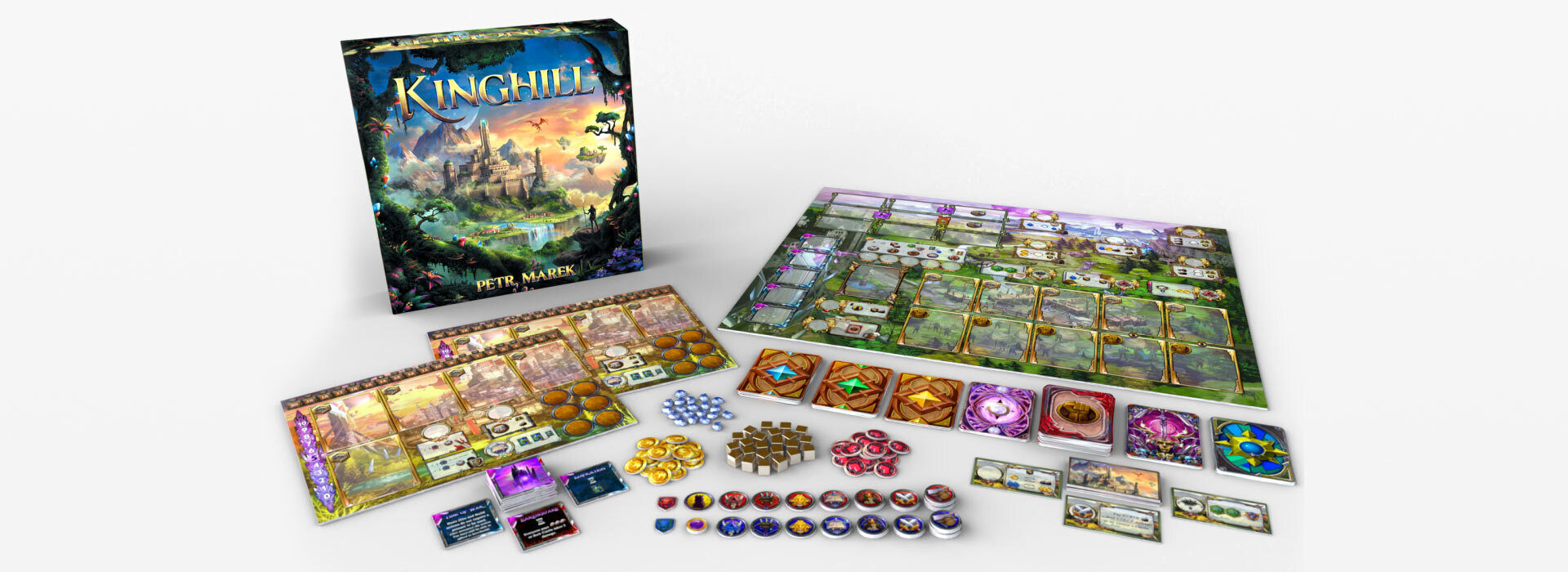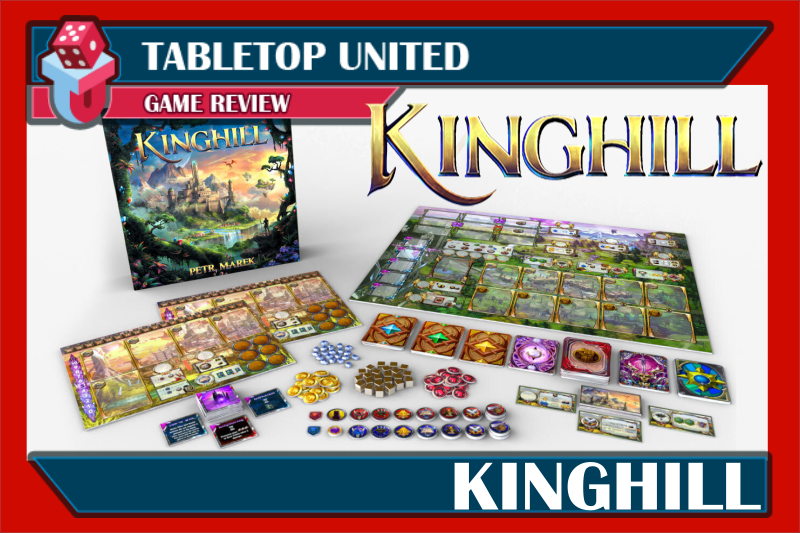
Kinghill
Designer: Petr Marek
Artist: Douglas Duarte, Tan Ho Sim
Publisher: Self Published
Kickstarted: October-November 2021
No. of Players: 1-2
Ages: 13+
Playing Time: 45- 90 minutes
Main mechanic / Theme: card drafting, competitive, worker placement, fantasy
Kinghill goes beyond deckbuilding and combines it with worker placement and other mechanics to bring you a streamlined and well-crafted head to head experience. Petr Marek has done an excellent job of building a game full of choices and excitement.
Find more info on BoardGameGeek.com
Find more information on Kickstarter.
Disclaimer: Publisher provided a prototype copy of the game for this review.
Overview:
As a general leading a mighty army, you will vie for dominance over two powerful artefacts. Lead your forces to defeat the opposing player’s army through careful card play and acquisition. Use your workers to gather resources or train them to become powerful allies which gain new abilities to help gain dominion.But be careful, other forces are at work and will enter the fray which when you least expect it, which will demand you to split your attention from your main focus- destroying the opposing general’s army and castle. 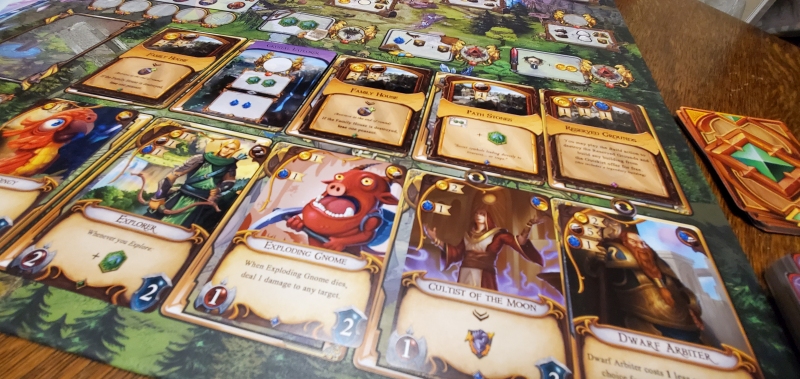
Players will take turns taking one action including assigning peasants to various action tiles, casting any spells or using a special action. End of round affects will take place once the action phase is over and a moonstone is gained by each player, followed by cleanup. Of course, the game involves more than that, which we will get to below.
Gameplay and mechanics:
The action tiles and spaces that players take advantage of are key to bringing defeat to your opponent as well as how you use the effects and resources gained. Most action tiles can have only one peasant. This means players have to decide whether to commit a peasant to that tile early or wait it out if a specific action is needed. Two actions spaces can hold multiple peasants- Hire and Spell Study. Essentially, hiring allows you to “buy” a unit card to help you offensively or defensively in your conquest while Spell Study allows you to secretly choose 1 of 2 cards drawn from the spell deck.
Since action tiles and spaces help you gather more resources and ways to outmaneuver your opponent, you’ll need to be crafty to ensure that you choose the right space at the right moment. Some action tiles, like the Spell Study, require “specialist” peasants. In this case, you need mages in order to use that tile.
Basic action spaces that are part of every game include things like Train, where peasants learn skills and grow into specialists like mages, miners, rangers, soldiers, and more. Training your peasants opens up your choices and allows you to access additional action tiles. Other action tiles include the Mines, Steal, Hire, Explore, Kill, and First Player.
However, for action tiles, not every tile is used in each game. At set up, you’ll place tiles face down and any extra are returned to the box. This ensures that you get a different experience from the game each time you play. Some of the other action tiles that you’ll get access to include gaining an extra peasant, copy an action, gaine or explore force which allows you to gain resources and force, build and hire, extra attack, trade, and more. I was pleasantly surprised by the various options of the action tiles. Allowing a chance to copy another occupied action is amazing. In addition, tiles like extra attack means that both players could be more aggressive than normal, allowing for you to take down the opponent’s castle more quickly.
In addition to the actions on the board and action tiles, there are castle actions such as attacking, defending, and building. Attacking and defending are part of combat while building allows you to grab a building and put it on the Castle Sheet after paying it’s cost.
Although there are several actions available, you’ll find that having a strategy is important in order to take down your opponent’s castle. Do you focus on building things and add those new buildings to your castle or do you try to grab as many peasants and turn them into specialists as possible? The game provides several different game-play strategies, making a great replayable game.
In order to become the champion, you’ll need to manage your actions in addition to your resources (although workers are typically a resource, in this case, the are three resources you’ll want to procure). The resources you’ll want to gather for various benefits, tiles, etc, include stone for building such things as buildings and protecting from earthquakes. The currency of Kinghill are Lunar Coins. Coins of course are spent when buying or taking specific actions. Lastly, a unique resource you’ll definitely want are magic crystals. To cast spells you’ll want to collect these while you’ll want to use them to hire specific specialists or to build powerful buildings.
Peasants are interesting as you have to train them to become specialists, which aid you. Specialists include mages which can cast spells, soldiers help with combat while miners are able to gather more resources and help with growing your kingdom. Rangers explore the wilderness beyond your castle. Assassins are able to use the “steal” and “kill” action spaces. Lastly, sages are found roaming the wilderness and have the knowledge of the other professions, so, claiming a sage is very beneficial.
Players begin with two basic peasants and automatically gain two more throughout the game. In addition, players are limited on the number and types of specialists, so be careful about reaching your limit. Of course, the more peasants and specialists you have, the more actions you have open to you. You have to decide which route you want to take and when to train your peasants. If a peasant is out training, they aren’t out collecting resources for you!
Throughout the game, various magical effects from the Moonstone will give you and your opponent either benefits or detriments. Powers are flipped throughout the game but you are guaranteed to flip two of them after the 2nd and 4th round, however, there is the possibility that five powers will come into play, causing you and your opponent to adapt to the Moonstone. A couple of those powers include allowing players to draw an extra spell card or cause earthquakes which damage your castle unless you pay 3 stone. Since the tiles are facedown, you don’t quite know what will happen until a power is flipped face-up.
Speaking of powers, each player controls a powerful moonstone and players gain force from each moonstone and this force is gained automatically at the end of each round. Using force cards helps players, but drawing force cards means you have to place a face down power tile. If the power tracker gets full, a power tile will flip!
The main type of card you’ll be grabbing to conquer your enemy is the unit card. You’ll have to hire these units, most commonly through the hire actions. Each unit card has a cost, explore, ability, strength, and a defense value. The strength of a unit determines how much damage it deals while the defense is used as a way to mitigate castle damage but also represents that unit’s specific hit point value.
No matter how you play the game or what strategy you favor, you’ll need to go through combat. Combat comes from taking the attack action. There are two phases to follow, the castle attack phase and the unit fight phase.
For the castle attack phase, you’ll choose units to help with offense, assign peasants to defend, and play any other cards or soldiers you may have to help with the attack. After all bonuses are figured from spells or various other effects, the defender will follow a similar path and count up their defense points. Subtract defense from the attacker’s points, and the difference is how much damage the castle takes. The castle attack phase is done.
The second part is unit fight phase. Here, the attacker will choose units with which to fight the opponent’s units. Each unit gets to attack only one target or multiple units may choose to attack one target. Spells may then be played. From there, add up the attack strength of a unit vs the defense strength of a unit and apply damage based on that difference. Once all chosen units are done attacking, the attack action is finished.
You’ll definitely want to attack and do damage to the castle as that is the main way to defeat your opponent. You can’t sit back and turtle up and play the long game.
Just as there are requirements to hiring units, building buildings, there are requirements to casting spells. Magic crystals are used to pay for a spell’s use. Each spell card has a top and bottom, and when played, you have to decide which part to use- the top or bottom. The bottom effect is typically stronger as it costs two crystals instead of one crystal.
As mentioned above, the route to victory is typically through destroying your opponent’s castle. However, at the end of the 9th round, the player with the most castle strength is the winner. Turtling up and defending has it’s advantages but, typically, won’t win you the game. In case of ties, the player with the most force wins.
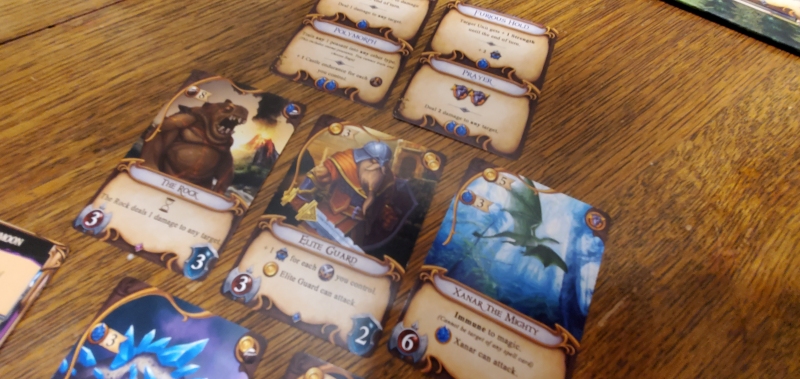
Theme, Artwork and Illustration, Graphic Design and Layout
The publisher has gone through great lengths to make sure that each card is well represented and is interesting. In a fantasy setting, your typical fighters, elves, dwarves, dragons, etc, are well-represented, but Petr Marek has made sure that his world of Kinghill has some unique representations and represents the world of Kinghill well. I found the many different parts a bit confusing, especially during set up. With the different action tiles, power tiles, various card stacks, main board, castle board, etc, I was a bit overwhelmed. I had to diligently read through the rules to make sure I had things set up correctly and in the right place.
However, once the game was underway, play felt ergonomic and I didn’t have trouble figuring out icons nor how to use abilities. Beyond set up, the game didn’t feel overly complex like I feared. For me, locations were well-marked and finding where to use an action vs buying a building came easier after setting up the game. The cards, tiles, and other material were easy to read and costs, abilities, and text was easy to read and to find on a card or tile.
It took me two playthroughs to start gathering a bit more of the strategy behind the game as well as what actions I needed to take in order to move forward. I think that was part of the learning curve, as there is quite a bit to dig into in Kinghill. I didn’t find it difficult, just that I wasn’t sure on the best actions or choices to make the first time through.
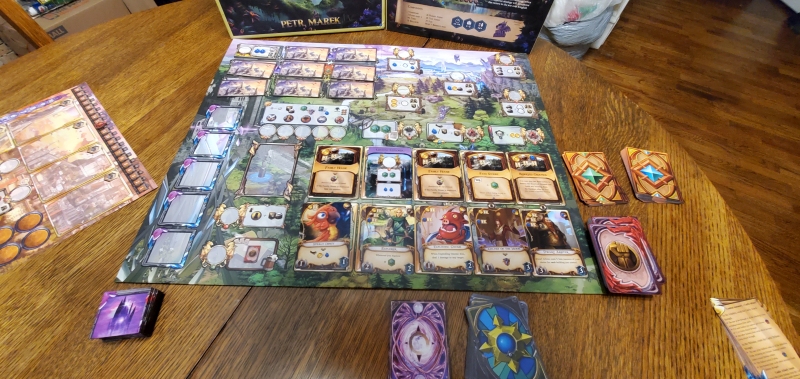
Inclusivity and Accessibility:
Tabletop United believes that diversity is a source of fun and happiness. Nurturing and celebrating our personal differences can lead to amazing gaming (and life) experiences.Therefore, TTU is putting renewed emphasis on inclusivity and accessibility by adding a section in each of our reviews written after April 2021. You’ll begin to see more reviews with this section as time goes on. The inclusivity and accessibility section will critique those issues and strengths of the subject in the review based upon the unique background of the reviewer. Each reviewer views the world through their own particular lens and has a wide and varied experience from which they will write and review from.
Being color-blind, I was quickly reassured that I didn’t have any problems with colors used in the game. If a color marked something, so too did an icon or other similar way mark cards or tiles.
The game opens up as you play it more (at least from my experience) and for those who may not get or understand a game right away this may not be the right game to jump into without understanding there may be a learning curve. Just to clarify, that was my experience and others may not have the same curve that I had.
What worked:
As I played through my second game, I loved the options available to me. The game seemed to open up as I experienced the different aspects and began to work on a strategy. My opponent kept having “aha!” moments as well as we both become more experienced with the flow of the game and what we could do with our peasants. It became apparent that the more we played the more the game offered.
Final thoughts:
After playing the game a few times I was happy that I stuck with it. It’s a great feeling when playing a game and you get inspiration and pick out a strategy that you can follow. Kinghill does that. The game should appeal to people who love building a deck and having their engine grow. Having your workers (peasants) train into specialists and also adding new peasants to your court really feels like you are making progress. The option of pulling cards and deciding which part of the spell card to use at the right time also feels like you and your kingdom become more powerful.
People who like head to head games will love this game as it provides good depth and various options to complete your strategy
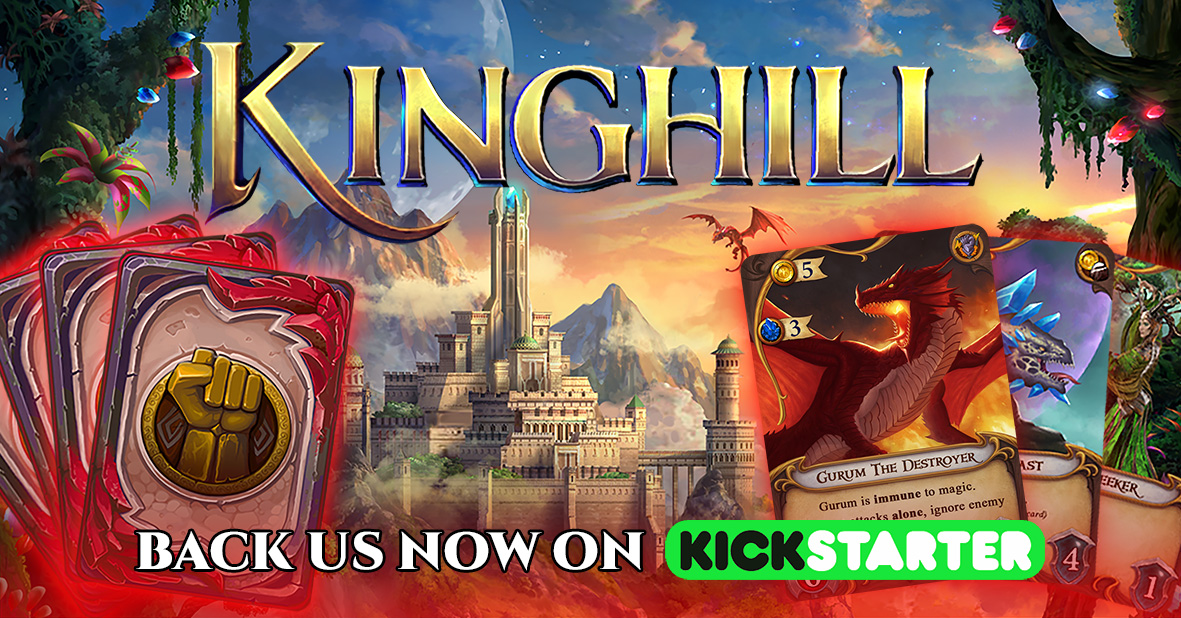
Kinghill is currently on Kickstarter and has successfully been funded. You can find the link here: https://www.kickstarter.com/projects/kinghill/kinghill/description.

